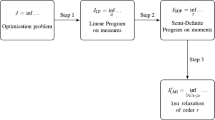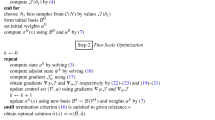Abstract
In this preliminary report, two optimization approaches, gradient descent with automatic differentiation and particle swarm optimization, are presented, applied, and compared in an effort to leverage dynamic information collected during contrast-enhanced medical imaging of tumors to estimate four blood flow parameters: perfusion, permeability surface area product, volume of the plasma, and volume of the interstitial space. Using Fick’s law on a simple two-compartment model, the resulting PDEs are numerically integrated using a collocation method for a set of boundary and initial conditions and known values of the parameters, and the resulting tracer concentrations were spatially integrated to generate truth data of signal intensity as a function of time only. After using physical constraints on the boundaries to recover reasonable estimates for two of the parameters, the two optimization approaches are used in an attempt to recover estimates for the remaining two parameters. The resulting efficacy and efficiency of the two optimization approaches are compared.
Similar content being viewed by others
References
Armijo, L.: Minimization of functions having Lipschitz continuous first partial derivatives. Pac. J. Math. 16(1), 1–3 (1966)
Bartholomew-Biggs, M., Brown, S., Christianson, B., Dixon, L.: Automatic differentiation of algorithms. J. Comput. Appl. Math. 124(1–2), 171–190 (2000)
Baydin, A.G., Pearlmutter, B.A., Radul, A.A., Siskind, J.M.: Automatic differentiation in machine learning: a survey. J. Mach. Learn. Res. 18(153), 1–43 (2018)
Brix, G., Bahner, M.L., Hoffmann, U., Horvath, A., Schreiber, W.: Regional blood flow, capillary permeability, and compartmental volumes: measurement with dynamic CT—initial experience. Radiology 210(1), 269–276 (1999)
Cauchy, A.: Méthode générale pour la résolution des systemes d’équations simultanées. Comp. Rend. Sci. Paris 25, 536–538 (1847)
Cohen, A.I.: Stepsize analysis for descent methods. J. Optim. Theory Appl. 33(2), 187–205 (1981)
Dong, Y., Wang, W.-P., Mao, F., Ji, Z.-B., Huang, B.-J.: Application of imaging fusion combining contrast-enhanced ultrasound and magnetic resonance imaging in detection of hepatic cellular carcinomas undetectable by conventional ultrasound. J. Gastroenterol. Hepatol. 31(4), 822–828 (2016)
Georgiou, L., Sharma, N., Broadbent, D.A., Wilson, D.J., Dall, B.J., Gangi, A., Buckley, D.L.: Estimating breast tumor blood flow during neoadjuvant chemotherapy using interleaved high temporal and high spatial resolution MRI. Magn. Reson. Med. 79(1), 317–326 (2018)
Goldstein, A.A.: Cauchy’s method of minimization. Numer. Math. 4(1), 146–150 (1962)
Kennedy, J.: Particle swarm optimization. In: Sammut, C., Webb, G.I. (eds.) Encyclopedia of Machine Learning, pp. 760–766. Springer, Berlin (2011)
Libertini, J.M: Determining tumor blood flow parameters from dynamic image measurements. In: Journal of Physics: Conference Series, vol. 135(1), p. 012062. IOP Publishing (2008)
Matyas, J.: Random optimization. Autom. Remote Control 26(2), 246–253 (1965)
Price, W.L.: A controlled random search procedure for global optimisation. Comput. J. 20(4), 367–370 (1977)
Shaw, C.M., Eisenbrey, J.R., Lyshchik, A., O’Kane, P.L., Merton, D.A., Machado, P., Pino, L., Brown, D.B., Forsberg, F.: Contrast-enhanced ultrasound evaluation of residual blood flow to hepatocellular carcinoma after treatment with transarterial chemoembolization using drug-eluting beads: a prospective study. J. Ultrasound Med. 34(5), 859–867 (2015)
Shi, Y., et al.: Particle swarm optimization: developments, applications and resources. In: Proceedings of the 2001 Congress on Evolutionary Computation (IEEE Cat. No. 01TH8546), vol. 1, pp. 81–86. IEEE (2001)
Theek, B., Opacic, T., Möckel, D., Schmitz, G., Lammers, T., Kiessling, F.: Automated generation of reliable blood velocity parameter maps from contrast-enhanced ultrasound data. In: Contrast Media & Molecular Imaging (2017)
Wright, A.H.: Genetic algorithms for real parameter optimization. In: Spatz, B.M. (ed.) Foundations of Genetic Algorithms, vol. 1, pp. 205–218. Elsevier, Amsterdam (1991)
Acknowledgements
The work in this paper is presented in memory of Professor David Gottlieb and Professor Saul Abarbanel, both of whom were instrumental in the initial framing of this problem and in the professional development and mentorship of the primary author, J. Libertini, who is paying it forward through her mentorship of her students, namely, K. Chang and S. Seay, the other authors on this paper. She also acknowledges Spencer Hansen, who worked with her on this project for his honors thesis at the U.S. Military Academy. She would also like to acknowledge and thank Professor Sidi Kaber for his pivotal contributions in the initial development of the automatic differentiation approach.
Author information
Authors and Affiliations
Corresponding author
Additional information
Publisher's Note
Springer Nature remains neutral with regard to jurisdictional claims in published maps and institutional affiliations.
Rights and permissions
About this article
Cite this article
Chang, KP., Libertini, J.M. & Seay, S. Comparing Gradient Descent with Automatic Differentiation and Particle Swarm Optimization Techniques for Estimating Tumor Blood Flow Parameters in Contrast-Enhanced Imaging. J Sci Comput 81, 1567–1576 (2019). https://doi.org/10.1007/s10915-019-01099-7
Received:
Revised:
Accepted:
Published:
Issue Date:
DOI: https://doi.org/10.1007/s10915-019-01099-7




